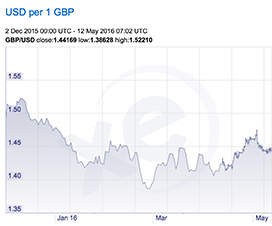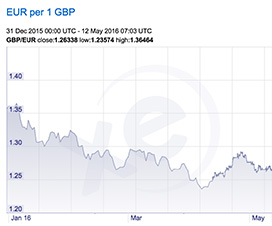With the recent but ever so brief glimpse of summer, our thoughts may have turned to summer holidays and the lure warmer climates. Before the Easter break however, David Cameron was encouraging us all to consider a holiday at home, until he was pictured abroad on his own holiday!
But was the advice to stay at home wiser than first thought? The recent fluctuations in the value of sterling might just cause us to think again about ventures away from the British shores.
Fail to prepare, prepare to fail
Any time we – as holidaymakers – transact in another currency, there is always that waiting game to secure the best rate and save a few pence. But when it comes to business, making the rate call on when to fix currency rates has much higher stakes.
Take Easyjet as an example. Despite announcing some impressive growth in revenue and passenger numbers, overall quarterly profits lurched from a glowing £7m in the first quarter of 2015 to an eye-watering £24m loss for the same period in 2016.
So in an ever increasing world of global trade, is it time for SMEs to take the plunge or do the fluctuations of currency outweigh the business opportunity and favour staying at home?
What is evident is that any venture into foreign trade – whether through import or export or simply trading in currency other than sterling – needs careful planning.
The turbulent path of sterling
So what was Easyjet’s reason for such a dramatic change in profits? Well they almost entirely attributed to the softening of sterling against the euro. Their own analysis suggested that if sterling remained flat, like for like profits would have dropped by just £2m not £31m. So how can this really be?
At the start of 2016, £1 was worth in the region of €1.36. So far so good. Wind on two months however and that same £1 would get you around €1.26, a fall of 7.5%.

When we consider the percentage adjustment in such a short space of time, it is clear to see that this fall in revenue – because of exchange rates losses – can have a big impact on operating profit. But this is not just a problem for the public companies.
“Easyjet is the latest but certainly not the last company to cite adverse currency moves to explain lost profits. However, the impact is often even more forcefully felt by mid or small cap companies who wear a direct impact of currency market fluctuations.”
Richard de Meo – Foenix Partners
Should I stay or should I go?
So it is clear that currency fluctuations haven’t done businesses any favors, but the bigger cause for concern has been the EU referendum question.
Back in January many importers departed from their usual hedging policy off the back deflated sterling levels only to be caught out in February by the announcement of the June referendum date. This meant that the cost of their imports rose sharply due to increase sterling costs of importing.
UK exporters would look to enjoy the benefit of a weaker sterling. Selling overseas can be more attractive to the local market as prices drop relatively in other currencies. In the absence of any existing currency hedging, a nimble exporter can take advantage of selling at cheaper prices overseas. But this can present longer term issues.
A Hampshire based client took advantage of a similar situation 2 years ago and increased the export share of the business and grew from £8m to in excess of £12m over the course of a 12-month period. Whilst this all seemed like positive news, the financial results showed a significant change. Having set export prices on the first of January for the next 12 months, a strengthening sterling saw a similar reduction in gross margins. The actual profit on the increased export business was over £300,000 less due to the exchange rate fluctuations.
Time to listen to the safety announcement
This fascinating moment in Britain’s political history poses a unique and serious set of risks for the short term economic outlook, which will continue to translate into volatility in the value of the pound. Sidestepping talk of results either way, the biggest risk to UK companies with direct currency exposure is the temptation to do nothing – there must be an FX strategy, however simple.
For any business an 8% drop in margin is going to cause some pretty significant changes in profitability. It is clear that some planning is required for all business’ that face this any international exposure.
Booking in advance really is the key to best value
There are a number of strategies that business’ can adopt ranging from the very simple; for example invoicing in sterling and insisting suppliers do the same – through to more complex like forward protection. The key to planning is understanding your exposure. Once you realise how trading internationally can leave you open to these challenges, with professional help a plan to manage the risk can be implemented.
Any business that receives or sends out a foreign currency invoice has both transactional risk and translation risk. In simple terms, the value of what you do today, will not be the same value tomorrow when it comes to foreign trading. Sometime this can go in your favour, and other times it can cause significant financial headaches.
Planning does not have to be overly complicated, and some simple analysis of likely trading can ensure that you are able to gain certainty, even if rates move against you.
It is vital that owner managed business keep their focus on doing business and remove the risk of an unwanted exchange loss that could turn a profitable growth business into a loss maker.
As for Easyjet it is clear that they are an airline operator and not a currency trader.
Comments based on the BBC News article titled ‘Easyjet hails ‘robust’ performance despite external challenges’
Posted in Blog, Hospitality & leisure